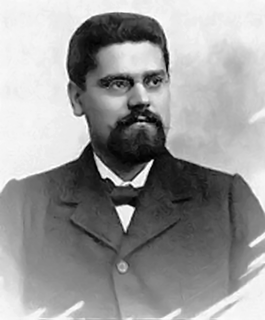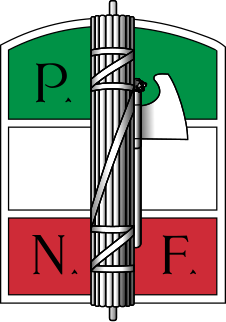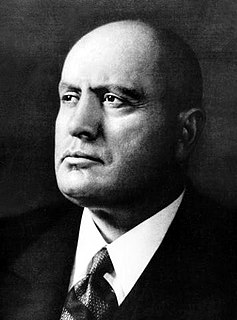
Fascism is a far-right, authoritarian, ultranationalist political ideology and movement, characterized by a dictatorial leader, centralized autocracy, militarism, forcible suppression of opposition, belief in a natural social hierarchy, subordination of individual interests for the perceived good of the nation and race, and strong regimentation of society and the economy.
Clerical fascism is an ideology that combines the political and economic doctrines of fascism with clericalism. The term has been used to describe organizations and movements that combine religious elements with fascism, receive support from religious organizations which espouse sympathy for fascism, or fascist regimes in which clergy play a leading role.

The March on Rome was an organized mass demonstration and a coup d'état in October 1922 which resulted in Benito Mussolini's National Fascist Party (PNF) ascending to power in the Kingdom of Italy. In late October 1922, Fascist Party leaders planned an insurrection, to take place on 28 October. When fascist demonstrators and Blackshirt paramilitaries entered Rome, Prime Minister Luigi Facta wished to declare a state of siege, but this was overruled by King Victor Emmanuel III. On the following day, 29 October 1922, the King appointed Mussolini as Prime Minister, thereby transferring political power to the fascists without armed conflict.
Statolatry, which combines idolatry with the state, first appeared in Giovanni Gentile's Doctrine of Fascism, published in 1931 under Mussolini's name, and was also mentioned in Gramsci's Prison Notebooks (1971) sometime between 1931–1932, while he was imprisoned by Mussolini. The same year, the encyclical Non abbiamo bisogno by Pope Pius XI criticized Fascist Italy as developing "a pagan worship of the state" which it called "statolatry".

Piero Gobetti was an Italian journalist, intellectual and radical liberal and anti-fascist. He was an exceptionally active campaigner and critic in the crisis years in Italy after the First World War and into the early years of Fascist rule.

The Biennio Rosso was a two-year period, between 1919 and 1920, of intense social conflict in Italy, following the First World War. The revolutionary period was followed by the violent reaction of the fascist blackshirts militia and eventually by the March on Rome of Benito Mussolini in 1922.

The history of fascist ideology is long and it draws on many sources. Fascists took inspiration from sources as ancient as the Spartans for their focus on racial purity and their emphasis on rule by an elite minority. Fascism has also been connected to the ideals of Plato, though there are key differences between the two. Fascism styled itself as the ideological successor to Rome, particularly the Roman Empire. From the same era, Georg Wilhelm Friedrich Hegel's view on the absolute authority of the state also strongly influenced fascist thinking. The French Revolution was a major influence insofar as the Nazis saw themselves as fighting back against many of the ideas which it brought to prominence, especially liberalism, liberal democracy and racial equality, whereas on the other hand, fascism drew heavily on the revolutionary ideal of nationalism. The prejudice of a "high and noble" Aryan culture as opposed to a "parasitic" Semitic culture was core to Nazi racial views, while other early forms of fascism concerned themselves with non-racialized conceptions of the nation.

The "Manifesto of Race", otherwise referred to as the Charter of Race or the Racial Manifesto, was a manifesto which was promulgated by the Council of Ministers on the 14th of July 1938, its promulgation was followed by the enactment, in October 1938, of the Racial Laws in Fascist Italy (1922–1943) and the Italian colonial empire (1923–1947).

Italian fascism, also known as classical fascism or simply fascism, is the original fascist ideology as developed in Italy by Giovanni Gentile and Benito Mussolini. The ideology is associated with a series of two political parties led by Benito Mussolini: the National Fascist Party (PNF), which ruled the Kingdom of Italy from 1922 until 1943, and the Republican Fascist Party that ruled the Italian Social Republic from 1943 to 1945. Italian fascism is also associated with the post-war Italian Social Movement and subsequent Italian neo-fascist movements.
Il Popolo d'Italia was an Italian newspaper published from 15 November 1914 until 24 July 1943. It was founded by Benito Mussolini as a pro-war newspaper during World War I, and it later became the main newspaper of the Fascist movement in Italy after the war. It published editions every day with the exception of Mondays.
Squadrismo was the movement of squadre d’azione, the fascist militias organized outside the authority of the Italian state and led by local leaders called ras. The militia originally consisted of farmers and the middle-class people creating their own defense against revolutionary socialists. Squadrismo became an important asset for the rise of the National Fascist Party led by Benito Mussolini, using violence to systematically eliminate any political parties which were opposed to Italian Fascism. This violence was not solely an instrument in politics, but was also a vital component of squadrismo identity, which made it difficult for the movement to be tamed. This was shown in the various attempts by Mussolini to control squadrismo violence, with the Pact of Pacification, and finally with the Consolidated Public Safety Act. Squadrismo, which ultimately became the Blackshirts, served as a source of inspiration for Adolf Hitler’s S.A.

The "Manifesto of Fascist Intellectuals", by the actualist philosopher Giovanni Gentile in 1925, formally established the political and ideologic foundations of Italian Fascism. It justifies the political violence of the Blackshirt paramilitaries of the National Fascist Party, in the revolutionary realisation of Italian Fascism as the authoritarian and totalitarian rėgime of Prime Minister Benito Mussolini, who ruled Italy as Il Duce, from 1922 to 1943.

The National Fascist Party was a political party in Italy, created by Benito Mussolini as the political expression of Italian Fascism and as a reorganization of the previous Italian Fasces of Combat. The party ruled the Kingdom of Italy from 1922 when Fascists took power with the March on Rome until the fall of the Fascist regime in 1943, when Mussolini was deposed by the Grand Council of Fascism. It was succeeded, in the territories under the control of the Italian Social Republic, by the Republican Fascist Party, ultimately dissolved at the end of World War II.

The Arditi del Popolo was an Italian militant anti-fascist group founded at the end of June 1921 to resist the rise of Benito Mussolini's National Fascist Party and the violence of the Blackshirts (squadristi) paramilitaries. It grouped revolutionary trade-unionists, socialists, communists, anarchists, republicans, anti-capitalists, as well as some former military officers, and was co-founded by Giuseppe Mingrino, Argo Secondari and Gino Lucetti – who tried to assassinate Mussolini on 11 September 1926 – the deputy Guido Picelli and others. The Arditi del Popolo were an offshoot of the Arditi elite troops, who had previously occupied Fiume in 1919 behind the poet Gabriele d'Annunzio, who proclaimed the Italian Regency of Carnaro. Those who split to form the Arditi del Popolo were close to the anarchist Argo Secondari and were supported by Mario Carli. The formazioni di difesa proletaria later merged with them. The Arditi gathered approximately 20,000 members in summer 1921.

Novecento Italiano was an Italian artistic movement founded in Milan in 1922 to create an art based on the rhetoric of the fascism of Mussolini.

Benito Amilcare Andrea Mussolini was an Italian politician and journalist who founded and led the National Fascist Party. He was Prime Minister of Italy from the March on Rome in 1922 until his deposition in 1943, and "Duce" of Italian Fascism from the establishment of the Italian Fasces of Combat in 1919 until his execution in 1945 by Italian partisans. As dictator of Italy and principal founder of fascism, Mussolini inspired and supported the international spread of fascist movements during the inter-war period.

The Italian racial laws, otherwise referred to as the Racial Laws, were a series of laws which were promulgated by the Council of Ministers in Fascist Italy (1922–1943) from 1938 to 1943 in order to enforce racial discrimination and segregation in the Kingdom of Italy. The main victims of the Racial Laws were Italian Jews and the native African inhabitants of the Italian colonial empire (1923–1947). In the aftermath of Mussolini's fall from power, the Badoglio government suppressed the Racial Laws in the Kingdom of Italy. They remained enforced and were made more severe in the territories ruled by the Italian Social Republic (1943–1945) until the end of the Second World War.
Richard James Boon Bosworth is an Australian historian and author, and a leading expert on Benito Mussolini and Fascist Italy, having written extensively on both topics.

The Kingdom of Italy was governed by the National Fascist Party from 1922 to 1943 with Benito Mussolini as prime minister. The Italian Fascists imposed authoritarian rule and crushed political and intellectual opposition, while promoting economic modernization, traditional social values and a rapprochement with the Roman Catholic Church. According to Payne (1996), "[the] Fascist government passed through several relatively distinct phases". The first phase (1922–1925) was nominally a continuation of the parliamentary system, albeit with a "legally-organized executive dictatorship". The second phase (1925–1929) was "the construction of the Fascist dictatorship proper". The third phase (1929–1934) was with less interventionism in foreign policy. The fourth phase (1935–1940) was characterized by an aggressive foreign policy: the Second Italo-Ethiopian War, which was launched from Eritrea and Somaliland; confrontations with the League of Nations, leading to sanctions; growing economic autarky; invasion of Albania; and the signing of the Pact of Steel. The fifth phase (1940–1943) was World War II itself which ended in military defeat, while the sixth and final phase (1943–1945) was the rump Salò Government under German control.
Lo Sport Fascista was a monthly sports magazine which was published in Milan, Italy, during the fascist rule as the official organ of the fascist government. The magazine was in circulation between 1928 and 1943.













